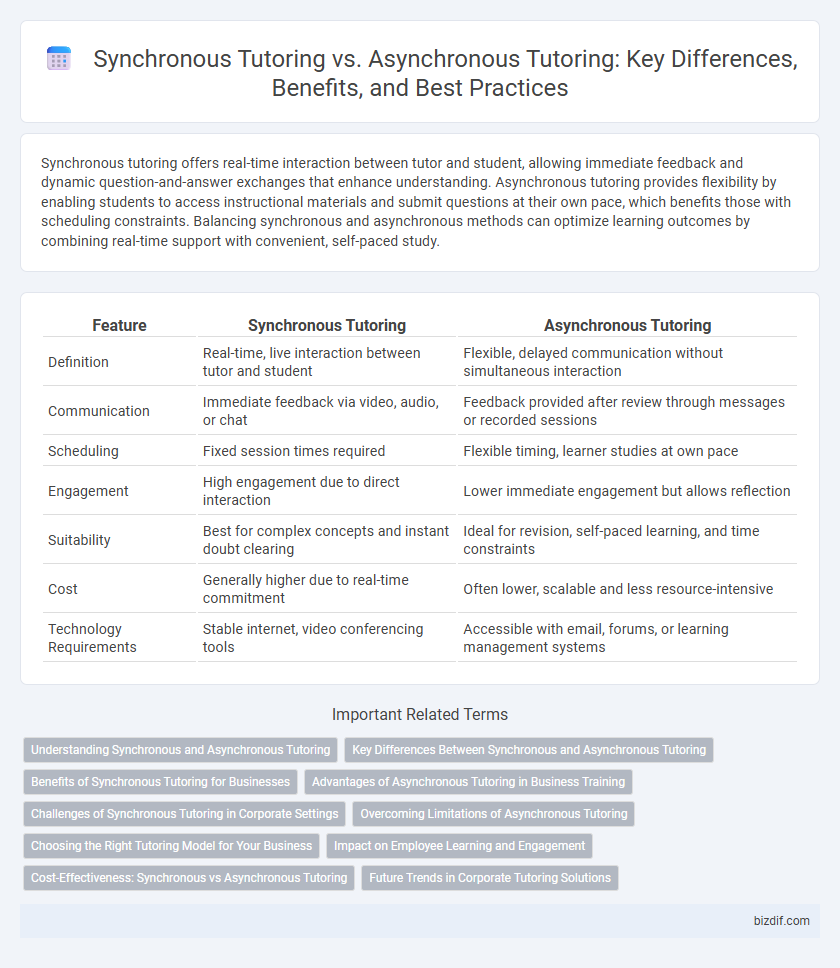Synchronous tutoring offers real-time interaction between tutor and student, allowing immediate feedback and dynamic question-and-answer exchanges that enhance understanding. Asynchronous tutoring provides flexibility by enabling students to access instructional materials and submit questions at their own pace, which benefits those with scheduling constraints. Balancing synchronous and asynchronous methods can optimize learning outcomes by combining real-time support with convenient, self-paced study.
Table of Comparison
| Feature | Synchronous Tutoring | Asynchronous Tutoring |
|---|---|---|
| Definition | Real-time, live interaction between tutor and student | Flexible, delayed communication without simultaneous interaction |
| Communication | Immediate feedback via video, audio, or chat | Feedback provided after review through messages or recorded sessions |
| Scheduling | Fixed session times required | Flexible timing, learner studies at own pace |
| Engagement | High engagement due to direct interaction | Lower immediate engagement but allows reflection |
| Suitability | Best for complex concepts and instant doubt clearing | Ideal for revision, self-paced learning, and time constraints |
| Cost | Generally higher due to real-time commitment | Often lower, scalable and less resource-intensive |
| Technology Requirements | Stable internet, video conferencing tools | Accessible with email, forums, or learning management systems |
Understanding Synchronous and Asynchronous Tutoring
Synchronous tutoring involves real-time interaction between tutors and students, allowing immediate feedback and dynamic discussion that fosters deeper understanding and engagement. Asynchronous tutoring offers flexibility by enabling students to access learning materials, submit questions, and receive responses on their own schedule, promoting self-paced study and reflection. Both methods leverage digital platforms but cater to different learning preferences and time constraints, significantly impacting the effectiveness of personalized educational support.
Key Differences Between Synchronous and Asynchronous Tutoring
Synchronous tutoring involves real-time interaction between tutor and student, enabling immediate feedback and dynamic discussion, which enhances engagement and clarifies complex concepts quickly. Asynchronous tutoring allows students to access materials and submit questions on their own schedule, providing flexibility and time for reflection but potentially delaying responses. Key differences include the timing of communication, level of interaction, and adaptability to individual learning paces, with synchronous tutoring favoring instant support and asynchronous supporting self-directed learning.
Benefits of Synchronous Tutoring for Businesses
Synchronous tutoring offers businesses real-time interaction that enhances immediate feedback and personalized support, leading to improved learner engagement and retention. This live communication fosters stronger client relationships and accelerates skill acquisition by addressing questions and challenges instantly. By facilitating dynamic and collaborative sessions, synchronous tutoring helps businesses optimize training outcomes and boost overall productivity.
Advantages of Asynchronous Tutoring in Business Training
Asynchronous tutoring in business training offers unmatched flexibility, allowing learners to access materials and complete tasks at their own pace, which enhances knowledge retention and accommodates diverse schedules. This method supports scalable training across different time zones without the need for synchronous presence, reducing costs associated with live sessions. It also enables detailed feedback and resource sharing, fostering deeper understanding and continuous improvement among employees.
Challenges of Synchronous Tutoring in Corporate Settings
Synchronous tutoring in corporate settings often faces challenges such as coordinating schedules across different time zones, which can disrupt productivity and limit participation. Real-time technical issues like connectivity problems and software glitches further hinder smooth communication and engagement. Additionally, maintaining learner attention during live sessions can be difficult due to distractions in the workplace environment.
Overcoming Limitations of Asynchronous Tutoring
Asynchronous tutoring overcomes its inherent limitations by integrating interactive tools such as discussion forums, video feedback, and real-time progress tracking to enhance learner engagement and support effective knowledge retention. Implementing AI-driven personalized responses accelerates the feedback loop, compensating for the lack of immediate teacher interaction. Blended approaches combining asynchronous content with scheduled synchronous check-ins help bridge gaps in communication, ensuring timely clarification and motivation for students.
Choosing the Right Tutoring Model for Your Business
Synchronous tutoring offers real-time interaction, enabling immediate feedback and personalized guidance, ideal for students needing direct support and engagement. Asynchronous tutoring provides flexible, self-paced learning through recorded sessions and digital resources, catering to learners with varied schedules. Choosing the right tutoring model depends on your target audience's preferences, accessibility needs, and your business's technological capabilities to ensure maximum effectiveness and client satisfaction.
Impact on Employee Learning and Engagement
Synchronous tutoring enhances employee learning and engagement by providing real-time interaction, immediate feedback, and collaborative problem-solving, which boosts motivation and retention. Asynchronous tutoring offers flexibility, allowing employees to learn at their own pace and revisit materials, supporting diverse learning styles and reducing scheduling conflicts. Combining both methods can optimize training effectiveness by balancing personalized support with adaptable learning environments.
Cost-Effectiveness: Synchronous vs Asynchronous Tutoring
Synchronous tutoring typically incurs higher costs due to real-time interaction requirements, such as scheduling constraints and increased tutor availability, while asynchronous tutoring reduces expenses by allowing flexible access to materials and self-paced learning. Asynchronous methods leverage digital platforms and recorded sessions, minimizing the need for continuous live tutor engagement, which significantly lowers operational costs. Choosing between synchronous and asynchronous tutoring depends on budget constraints and the value placed on immediate feedback versus cost savings.
Future Trends in Corporate Tutoring Solutions
Future trends in corporate tutoring solutions emphasize the integration of AI-driven platforms that blend synchronous tutoring's real-time interaction with the flexibility of asynchronous content access. Enhanced data analytics will tailor personalized learning pathways, optimizing employee skill development efficiently. Virtual reality and immersive technologies are set to revolutionize engagement, delivering simultaneous live coaching alongside on-demand resources.
Synchronous Tutoring vs Asynchronous Tutoring Infographic

 bizdif.com
bizdif.com